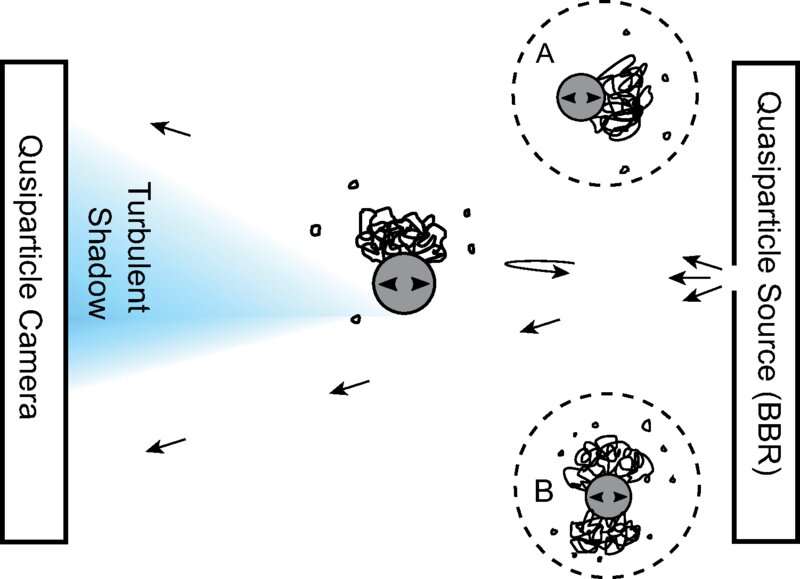A side-on sketch of the experiment with the most probable tangle configuration (not to scale). We illuminate the turbulence created by the wire with a quasiparticle flux emitted from the orifice of the blackbody radiator. A fraction of quasiparticles experience Andreev retroreflection, and retrace their path leaving a shadow behind the vortex tangle. The quasiparticle camera detects the reduction of flux and ‘images’ distribution of quantum turbulence formed by the wire. The insets A and B show tangle distribution resulting in symmetrical shadow: In (A) turbulence forms behind the wire's direction of motion, while in (B) turbulence develops above and below the wire. Credit: Physical Review B (2022). DOI: 10.1103/PhysRevB.105.174515
A team of physicists at Lancaster University has developed a camera system that can be used to capture the shadow of a sample of helium-3. In their paper published in the journal Physical Review B, the group describes their camera, their technique for using it and possible uses for the images it captures.
Helium-3 has particular interest for physicists due to its interesting internal structure, which some in the field have described as the "universe in a droplet." One of its properties is that it transitions to a superfluid when chilled to extremely low temperatures. As part of research efforts, physicists have found ways to detect it by using special probes to sense its weak magnetic field. They have found ways to "touch" it by pushing things through samples of it and measuring their impact. They have also discovered that it is possible to hear some of its characteristics using special microphones. In this new effort, the researchers have now developed a way to visualize it with a special camera system.
The camera system consisted of three main components suspended in a sample of helium-3. The first part of the system was a closed box that served as a source of quasiparticles. It had a device that broke Cooper pairs into quasiparticles, which found their way out of the box via a tiny hole at one end. Due to temperature differences, the quasiparticles flew straight out of the box and into the second part of the system. That second part consisted of a vibrating wire loop that created helium-3 vortices between the source; the third part of the system—the camera—is a 5 x 5 array of quartz tuning forks.
To create an image, quasiparticles were fired from the source into the vortices. Those quasiparticles that traveled close to a vortex were reflected back as holes toward the source. Those quasiparticles that did not pass sufficiently close to a vortex made their way to the camera. The final result was a shadow of the vortex tangle captured by the camera array.
More information: M. T. Noble et al, Producing and imaging quantum turbulence via pair-breaking in superfluid He3−B, Physical Review B (2022). DOI: 10.1103/PhysRevB.105.174515
Journal information: Physical Review B
© 2022 Science X Network























